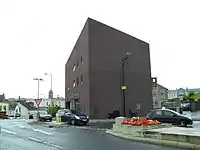The Clinton Centre
The Clinton Centre is situated on the site of the Remembrance Day bombing on 8 November 1987 in Enniskillen, County Fermanagh, Northern Ireland when the Provisional Irish Republican Army murdered 12 and injured 63 with a time bomb. Former President of the United States of America Bill Clinton gave his name to the facility in dedication to peace and prosperity in Ireland and around the world and has visited the site three times along with his wife, Hillary Clinton.

History of the building
The building stands on the site of the Reading Rooms owned by St. Michael’s Roman Catholic Church which was destroyed in the bombing in 1987. The Centre was conceived as part of the Higher Bridges Project, bridging this site with the former Enniskillen Orange Hall.

Plans were laid in 2000 to construct a new structure to balance the restored Orange Hall, a listed building. This was coordinated by Fermanagh University Partnership Board.[1]
In 2001 President Bill Clinton visited the site, returning again in 2002 to officially open the building and lend his name to it.[2] His most recent visit was in 2004 when he was accompanied by his wife, Senator Hillary Clinton, to witness the work being undertaken within the centre in peace-building projects.[3] The Centre housed a fully equipped conference floor, a restaurant, internet cafe and Art Gallery. Hostelling International Northern Ireland managed The Bridges Youth Hostel within the Clinton Centre until December 2012.[4]
In October 2017, Dublin City University, Ulster University and University of Massachusetts (UMass) came together in a joint initiative to renew and enhance the peace-building vision of the Clinton Centre in Enniskillen. President Clinton announced the initiative during a visit to Belfast. The new agreement will see the three universities unite to create a new, sustainable operational model for the Centre, in keeping with President Clinton’s commitment to peace and reconciliation on the island of Ireland. The plan will deliver a programme of both academic and cultural activities and events in the Centre over the next three years.[5]
In 2019 the non-profit organization UISCE (Understanding Ireland Socially, Culturally and Economically) launched a volunteer program to reestablish the purpose of the building,[6] with a view to primarily becoming an educational hub for students and emerging leaders focussing on peace building.[7]
References
- "Open invite on ideas to reopen Clinton Centre". Fermanagh Herald. April 2019.
- "Clinton visits Enniskillen to open peace centre". The Irish Times. 5 June 2002. Retrieved 6 November 2020.
- "Clintons visit Enniskillen peace centre". The Irish Times. 27 August 2004. Retrieved 6 November 2020.
- "Further blow as Clinton Centre set to lose £8,000 annual gallery income". The Impartial Reporter. June 2017.
- "Universities unite to regenerate Clinton Centre in Enniskillen | DCU".
- "Volunteering-UISCE".
- "What is happening at the Clinton Centre?". 2020.